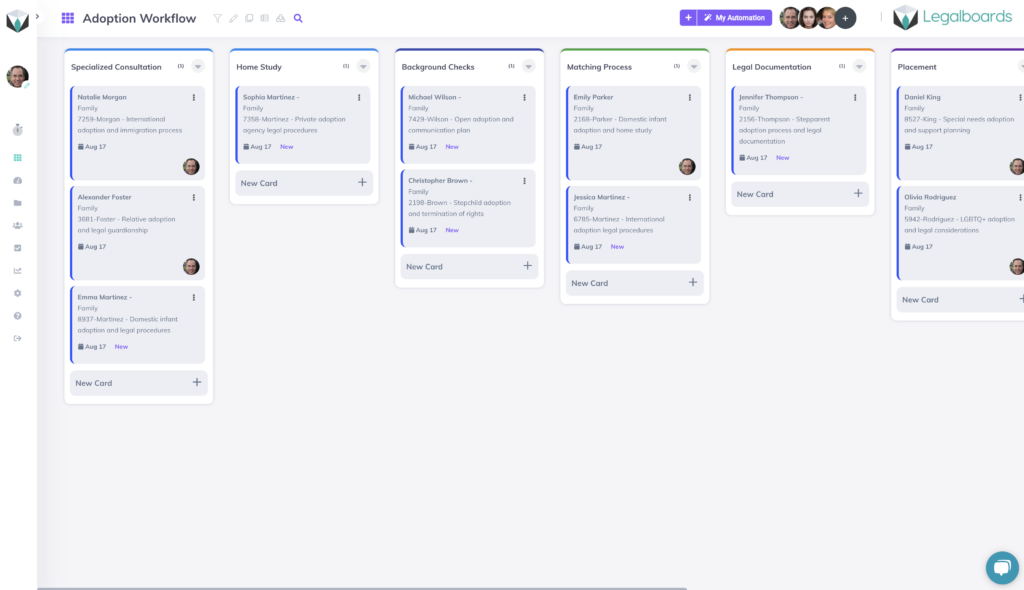Family law practices oversee a range of legal matters, from divorce to child custody, adoption, and more. To effectively manage these cases, having a well-defined workflow is essential. Let’s explore two workflow approaches that are tailored to the complex landscape of family law. From there, you can see how having a documented process can help your team.
General Family Law Workflow: One Board to Rule Them All
For a broad overview of family law cases, a single-board approach can be highly effective. This can be done by creating a centralized Kanban board where each column represents a different stage of the legal process. From initial consultations to court proceedings, this board visually tracks the entire journey of every case in a family law workflow.
Whether it’s divorce, adoption, or child custody, all sub-practice areas coexist within this streamlined workflow and offer a comprehensive view of your practice’s operations. With this overview, you’ll be able to get a bird’s eye view of your operations while also being able to drill down into specific matters or tasks as needed.
General Family Law Workflow: Board Organization
For this general board, let’s say we organize this board (shown below) where every case is included but categorized using colored labels for specific kinds of cases.

Complex Management: Specializations
Another option for organizing your workflow is to create a dedicated board for the intake process. This can make a world of difference when it comes to managing your client’s cases and providing them with superior client-led service.
Intake-Focused Workflow: Specialized Attention from the Start
This involves creating a tailored intake board where each column represents a different stage (for example, initial consultation, document collection, and assessment). Each new case enters this pipeline, ensuring a consistent intake process across all family law sub-practice areas.

Customized task automation can send clients essential documents, schedule appointments, and track progress. This specialized approach guarantees that from the beginning, no crucial details are forgotten.
Specialized Family Law Workflows: Divorce and Adoption
Finally, you could also organize your board by specific specialized workflows. Because family law covers a wide range of case types, it can help you to organize those that still roughly follow the same process or require similar management.
Two examples of this are divorce and adoption cases. These cases usually follow the same steps so using specific boards for each can be helpful. We’ll illustrate this with two examples.
Divorce Workflow
For divorce cases, you could create a dedicated workflow that includes stages like property division, custody negotiations, and settlement. In Legalboards, we have divorce board templates (learn more about that here) that can be customized to your specific needs.
Each column should represent a different stage of a case. This can be as detailed or high-level as you wish, but often having specific columns is much more helpful to you and your team. Custom fields can then capture financial details, while task automation ensures critical court deadlines are met.

Adoption Workflow
Adoption cases demand empathy and precision from legal professionals to deliver great service to clients. Developing a workflow with stages like home study, background checks, and finalization can help lawyers manage cases.
Task assignments can keep your team informed about important milestones, while automated reminders guarantee that time-sensitive actions are never overlooked.

Want to Get Started Quickly?
If you’re interested in getting started quickly with Legalboards, you can use one of our templates, which the process is shown below, or contact us for a dedicated setup session.
Conclusion
Family law requires workflows that balance flexibility and specificity that reflect the often delicate nature of this practice area. Implementing the Kanban framework can help legal professionals deliver superior service, improve client satisfaction, and enhance the efficiency and productivity of legal teams.
Whether you decide that a centralized board, intake-focused, or specialized boards are best for your workflow, it will aid you in gaining clarity about matters. With Legalboards, you can also easily implement this framework with a legal-specific solution to manage every aspect of your family law cases.







